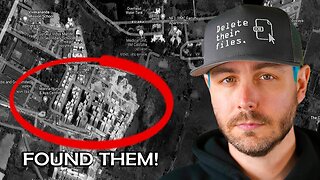Premium Only Content

Giant Scale Fokker Dr.1 Triplane RC Plane - Red Baron WWI Warbird at Warbirds Over Whatcom
This is some footage I took at last year's Warbirds Over Whatcom of a really cool Giant Scale Fokker Dr.1 Triplane RC Plane. Many people think of this as the Red Baron WWI Warbird.
Link to similar RC Planes: https://bit.ly/3Uio952
The links in this description are affiliate links. They give me a small commission on sales which helps support the channel and keep it independent: https://www.amazon.com/shop/gblyndensrc
Visit https://www.gblynden.com/ to learn more about the hobby!
RC Accessories:
- Spektrum Smart Checker: https://bit.ly/329hl12
- Spektrum IX20 Radio: https://amzn.to/3qFTbHe
- Spektrum AR620 Receiver: https://bit.ly/3Aay021
Other Fun RC Planes:
- Arrows Husky 1800mm PNP STOL RC Plane: https://bit.ly/3v3qQM9
- Arrows BAe Hawk EDF Jet: https://bit.ly/2VY0HB7
- Arrows T-33 EDF Jet: https://bit.ly/3h3Z24a
- Arrows F-86 EDF Jet: https://bit.ly/3hIli3C
- Arrows F-15 EDF Jet: https://bit.ly/3Cxi10D
- Arrows RC MiG-29 EDF Jet: https://bit.ly/2ZDmjBY
- Arrows RC Marlin EDF Jet: https://bit.ly/2LUe4cN
- Arrows T-28 Trojan RC Warbird: https://bit.ly/2LOr3N4
- Arrows Bigfoot RC Plane: https://bit.ly/2TJliVh
As you can tell from the screencap, this is no ordinary RC Plane. It is a Giant Scale RC Plane Fokker Dr.1 Triplane.
Here is some history on the real Fokker Dr.1 Triplane:
"In February 1917, the Sopwith Triplane began to appear over the Western Front.[1] Despite its single Vickers machine gun armament, the Sopwith swiftly proved itself superior to the more heavily armed Albatros fighters then in use by the Luftstreitkräfte.[2][3] Fokker-Flugzeugwerke responded by converting an unfinished biplane prototype into the V.4, a small, rotary-powered triplane with a steel tube fuselage and thick cantilever wings,[4] first developed during Fokker's government-mandated collaboration with Hugo Junkers. Initial tests revealed that the V.4 had unacceptably high control forces resulting from the use of unbalanced ailerons and elevators.[5]
Instead of submitting the V.4 for a type test, Fokker produced a revised prototype designated V.5. The most notable changes were the introduction of horn-balanced ailerons and elevators, as well as longer-span wings. The V.5 also featured interplane struts, which were not necessary from a structural standpoint, but which minimized wing flexing.[6] On 14 July 1917, Idflieg issued an order for 20 pre-production aircraft. The V.5 prototype, serial 101/17, was tested to destruction at Adlershof on 11 August 1917.[7]
Compared to the Albatros and Pfalz fighters, the Dr.I offered exceptional maneuverability. Though the ailerons were not very effective, the rudder and elevator controls were light and powerful.[13] Rapid turns, especially to the right, were facilitated by the triplane's marked directional instability.[13] Vizefeldwebel Franz Hemer of Jasta 6 said, "The triplane was my favorite fighting machine because it had such wonderful flying qualities. I could let myself stunt – looping and rolling – and could avoid an enemy by diving with perfect safety. The triplane had to be given up because although it was very maneuverable, it was no longer fast enough."[14]
-
 6:44
6:44
GBLynden's RC
11 months agoTim's Modded FMS Pitts V2 1400mm RC Biplane
163 -
 39:34
39:34
Nerdrotic
4 hours ago $11.05 earnedAirbursts with Dr Malcolm LeCompte & Giants and Ancient Civilizations with Hugh Newman
46.3K3 -
 1:03:38
1:03:38
vivafrei
11 hours agoElection RECAP! Long-Count Chicanery! FULL Jan. 6 Pardons! Let's Mock Lichtman & MORE! Viva Frei
112K94 -
 LIVE
LIVE
Vigilant News Network
5 hours agoDoctors Drop Post-Election COVID Bombshell | Media Blackout
4,097 watching -
 14:13
14:13
Scammer Payback
12 days agoTelling Scammers Their Address
108K80 -
 5:43:21
5:43:21
Barstool Gambling
9 hours agoBig Cat and Co Sweat Out the Week 10 Sunday Slate | Barstool Gambling Cave
79.6K3 -
 2:49:36
2:49:36
The Jimmy Dore Show
2 days agoRumble Time Live w/ Jimmy Dore & Special Guests Roseanne Barr, Dr. Drew, Drea de Matteo & More!
546K654 -
 17:17
17:17
DeVory Darkins
22 hours agoKamala Post-Election BOMBSHELL Exposes $1 BILLION Campaign DISASTER
75K154 -
 19:52
19:52
Stephen Gardner
1 day ago🔥HOLY CRAP! Trump just did the UNTHINKABLE!!
79.4K530 -
 4:34:55
4:34:55
Pepkilla
10 hours agoBlackops Terminus Zombies Boat Glitch
139K6